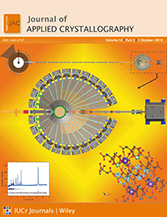issue contents
June 2024 issue
Early view articles

research papers
Open  access
access
 access
accessThe protein complex crystallography beamline BL19U1 is preparing for the establishment of an automated drug screening platform by upgrading both hardware and data collection control systems to optimize efficiency. The upgrade of the experimental station devices and data collection control system on the BL19U1 beamline are reported in this paper.
Open  access
access
 access
accessA new 2D representation of 3D material textures based on the Clifford torus is presented.
Open  access
access
 access
accessA tomography-based ray-tracing approach for analytical absorption corrections for X-ray crystallography is presented. Several examples from long-wavelength macromolecular crystallography experiments demonstrate the efficacy of this new method.
Bi2SiO5 thin films on Nb-doped (111), (110) and (111) SrTiO3 substrates exhibit ferroelectric and energy storage characteristics influenced by their various crystallinities.
Download citation


Download citation


This report describes an `order–disorder' transition in the recently discovered K2Ca3(CO3)4 material and the disordered β modification with an unusual K–Ca isomorphism in cation sites. The appearance of mixed K/Ca sites, in turn, causes strong orientational disorder of anions and the emergence of an inversion center (the ordered α modification is non-centrosymmetric).
Open  access
access
 access
accessBragg Spot Finder (BSF) is a U-Net-based spotfinder with image preprocessing, a U-Net segmentation backbone, and post-processing that includes artifact removal and watershed segmentation. BSF is supported by the Bragg Spot Detection (BSD) benchmark image dataset containing more than 300 images with more than 66 000 spots.
The intrusion of a ternary electrolyte solution (KCl + CaCl2) in pure silica chabazite is studied. The structural investigations reveal that the composition of the intruded species is different from those of the initial solution and that the K cations are separated from the Ca cations at the beginning of the intrusion. This seems to be due to different mechanisms of desolvation.
Open  access
access
 access
accessA novel high-efficiency 2D position-sensitive wavelength-shifting-fibre ZnS:Ag/6LiF scintillator detector has been developed at ISIS for single-crystal diffraction applications. More than a factor of 3 improvement in efficiency was achieved with this detector compared with clear-fibre scintillator detectors, and software routines for further optimizations in position sensitivity and uniformity have been implemented.
Open  access
access
 access
accessThe disequilibrium Sn content in Pb inclusions present in ancient (Sn,Cu)-bronze samples may in principle be used for authentication purposes. The present article explores the applicability of a method based on precise diffraction measurement of the Pb lattice parameter.
Open  access
access
 access
accessThis article discusses the phase-contrast effect and compares two simulation methods based on different theoretical frameworks. It demonstrates the ability to reproduce the phase effect in experimental data, using the well known simulation framework McStas [Willendrup & Lefmann (2020). J. Neutron Res. 22, 1–16].
short communications
Open  access
access
 access
accessA 3D-printed in situ crystallization plate is presented, which can be used to probe protein microcrystals in an external electric field.
computer programs
A computer program called Multifitting, which was developed to model the optical properties of multilayer films over a wide range of wavelengths, is described here. Its key features are the ability to work simultaneously with an arbitrary number of reflectometric and scatterometric experimental curves, and an ergonomic graphical user interface that is designed for intensive daily use in the characterization of thin films.
iModel is a 3D crystal structure visualization program that allows users to manipulate and customize models. Developed using LabVIEW and Python, it is a potentially powerful tool for crystal structure visualization.
Open  access
access
 access
accessThe program VUE analyses the distribution of 2D projections in cryo-EM and presents this information in a quantitatively exact manner via maps and other diagrams.

 journal menu
journal menu


































